
Animoca’s move into Bitcoin involves the Opal Protocol and BLIF token, initiated by Animoca and Darewise.
Cryptocurrency Financial News

Animoca’s move into Bitcoin involves the Opal Protocol and BLIF token, initiated by Animoca and Darewise.

Analysts from the London School of Economics and Political Science say a pan-European industrial cluster is necessary for the EU to compete in Web4.

YouTuber and Ultimate star MKBHD tested the device using a game controller, his legs, and the Force.

The European Union’s in-house think tanks says the metaverse can help children heal from diseases.

Imaginary Ones co-founder Clement Chia believes that simply adding blockchain to the metaverse doesn’t solve its “purpose” problems.

Each company has its own special plans for the Quest mixed-reality device.
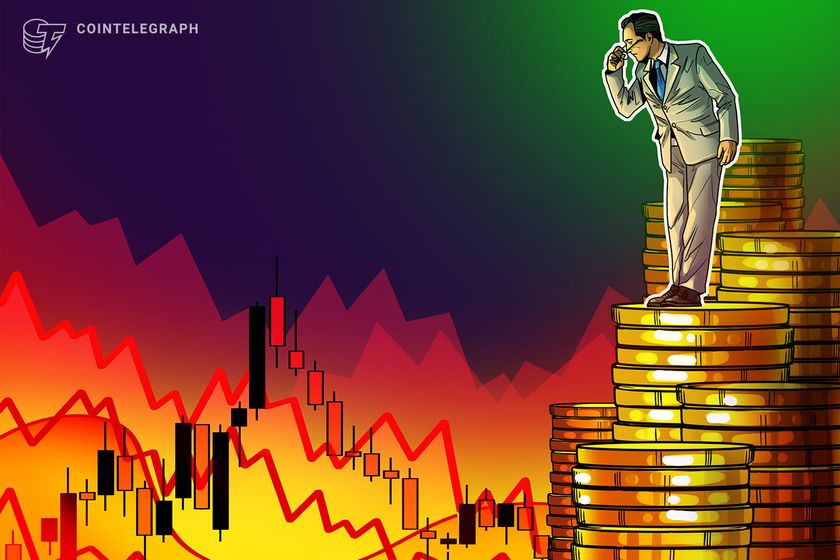
Meta shares dipped after a disappointing Q2 revenue outlook and plans to spend nearly $100 billion this year as it aims to “invest aggressively” in its AI products.

The collectibles will include “money can’t buy” experiences such as pitch-side seats for exclusive team training events.

It was supposed to be his last film but the project has been scrapped.
Metaverse tokens have a $18 billion market cap, but we’re not quite at Ready Player One yet.
The app is set to be released in the second qaurter and the token VR has already surged 60% in last 24 hours.
Mark Zuckerberg’s Meta said it was pivoting away from Metaverse to Artificial Intelligence in early 2023.
The Mixed Reality company has raised nearly $4 billion, as metaverse tokens are solidly in the green.
This is an interpretation of VESA’s appearance on the Human Generated podcast by Omid Honari. The two met during a day of keynote speeches at the Mohammed Bin Rashid library, where as it turns out, both of their topics touched on not only art and its implications, but also spirituality.
It was no wonder that when VESA and Omid sat down to record this podcast, the deeper topics were soon elaborated on.
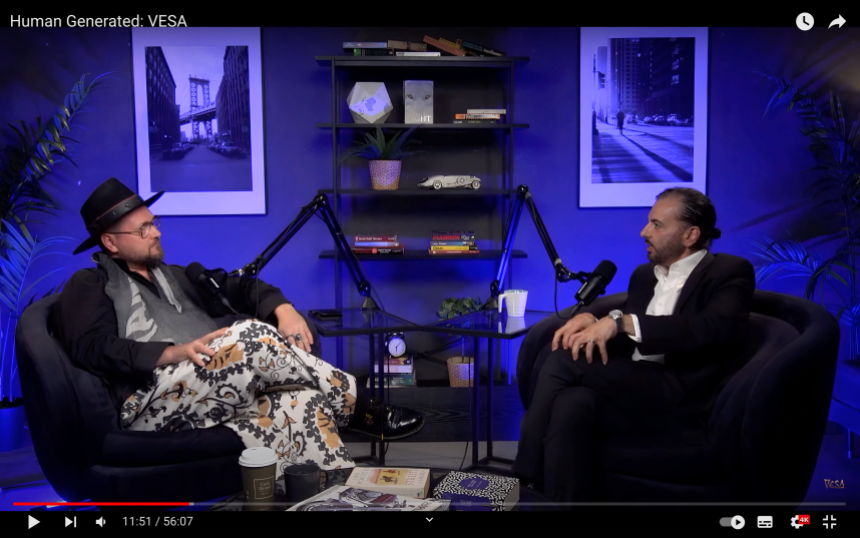 Watch the conversation on Youtube
Watch the conversation on Youtube
Watch it on Spotify
Why read further ( or return)?
Breakdown, links and illustrations:
The conversation took place in late May when Dubai was plunging into the hot temperatures. Vesa told that as a 44-year-old, the elapsing winter was the first where he had enjoyed consistent warm weather, being natively from Finland and having lived in the UK for several years.
‘There’s a lot of cold trauma still to be purged’, he said.
Omid relayed a piece of advice he heard as a boy that coping with cold is much easier than coping with heat, since you always have the option of adding a layer of clothing, but there is only so much you can remove. This advice also speaks to how personal our relationship with the weather and our immediate surroundings is. We rationalize our emotions towards it via stories and these pieces of advice that we tell each other.
 VESA and Omid met at the Mohammed bin Rashid Library in early 2023, where they both were speaking.
VESA and Omid met at the Mohammed bin Rashid Library in early 2023, where they both were speaking.
New Horizons
To delve right into the mouth of the beast, Omid poses an interesting proposition of the constellation of new technologies, NFTs, metaverse and the whole Web3 being at odds with the creative arts as we know it.
‘Most respectfully, I disagree with that, VESA starts.
VESA explains that one of the concepts that governs how he views art, and life itself, is Ken Wilber’s Integral Theory. This theory helps to see yourself, your contribution, philosophies, and beliefs as functional parts of the elaborate whole. This way of approaching art is not taught in colleges and universities, where most art history begins or at least emphasises the post-modern period without studying the roots of why humans began creating art in the first place, namely cave painting and body painting.
With a fractionalized outlook on art, new technologies can feel like a jarring, disjointed note in the melody of human creativity, whereas from the Integral point of view, these are tools that if utilized to their utmost potential, will remove the old gatekeeping systems for more creativity to blossom in society.
‘My LUXOR- inspired art gallery is a great example of this. It uses new technologies, it breaks barriers of entry and in substance, it studies the origins of art, VESA says.
‘It’ll take a little bit of time, and whether the traditional art institutions will adopt this remains to be seen, since their interest is so much in identity politics, but for people, this means total freedom’, he explains.
The Luxor Metaverse temple is live with Superworld
Possibilities or threats
Omid agrees that the limitation of the current arts education seems to be that it is taught from the perspective of the current ideological climate, and it must go along the epoch of our time and what that does is hides the vastness of possibility that is currently available.
Intrigued by VESA’s mention of primordial art, Omid asks next how does an artist with a capital A bridge together the gap of something so corporal, so essential as body paint with something as cerebral and intangible as the digital realm.
‘When I saw my first model with full body paint in my studio, I knew that this was it, it was like a superhero had appeared in front of me’, VESA says.
‘But when it comes to embarking on the digital journey, I had no other choice. My method dictated that my originals were digital ever since 2008, and this was a major issue for the art institutions before the advent of NFTs. They would ask for an oil original that I didn’t have’.
“Escapist” was the first bopypainting and photography based collage work VESA made in 2008.
‘The technology that facilitates Bitcoin is the turning point in digital scarcity and digital ownership, because it facilitates digital assets, like artworks, that are as rare as the physical Mona Lisa’.
Omid then points out that isn’t one of the most valuable digital artworks verified on the blockchain a picture of a monkey, homing in on his original point of new technologies diluting actual artistic endeavour.
‘There’s some genius marketing behind that project, and it gains its value also through being an access pass. What it’s not is art’, VESA explains.
‘How is the casual consumer going to gain an education about the difference between these two categories?’, Omid asks.
VESA explains that this is a deeper issue than what meets the eye, how in the words of the cultural critic Camille Paglia we are on the brink of another cultural Renaissance, should we take the steps to get there, but our institutions are not paving the way for our collective consciousness to get there. He also re-iterates the difference between the collectible digital art and the digitized fine art, where the only common factor is the underlying technology. Having said that, VESA expresses how positive it is that the gatekeeping of the old system is coming down due to technological advancements.
His native country Finland is a great example of this, where a lot of government grants are given only to art that perpetuates a certain narrative. This suffocates actual creativity and resembles more a high-school student, who studies what he knows the teacher cares the most about, not what is relevant.
 The Camille Paglia lecture “Art belongs to everyone” has been one of the themes that have inspired this direction of thought.
The Camille Paglia lecture “Art belongs to everyone” has been one of the themes that have inspired this direction of thought.
The Origins
As VESA has mentioned Finland, and the general climate of art there, Omid is interested to know how art and VESA came to be.
‘What was the origin story?’, he asks.
‘It’s always been about connection, and the two points in time that come to mind are my connection to music, and especially African drums that lit something up inside me, and my connection to something spiritual that I experienced, when I very nearly drowned as a six-year-old.’, VESA says.
‘At its best, it doesn’t even feel like I am the one who is doing it. And skill comes into play so that it takes a form that others might enjoy as well, but it’s always about that connection that drives everything I do creatively’.

The Knight Rider theme was the first song to get VESA to play to be a rock star as his toy plastic axe as the guitar, sliding on his knees across the room as a 5 year old.
‘So where is the divine for you, then?’ Omid asks.
‘One of the books that talks about this is called Flower of Life, and it explains that this pattern at the very core of everything that comes into being is all coming through the One, but the multitude of expressions that the One takes, is our experience of the world’,

The ancient secret of the flower of life was a significant book to read while travelling shooting a documentary in Egypt and Mexico in 2012.
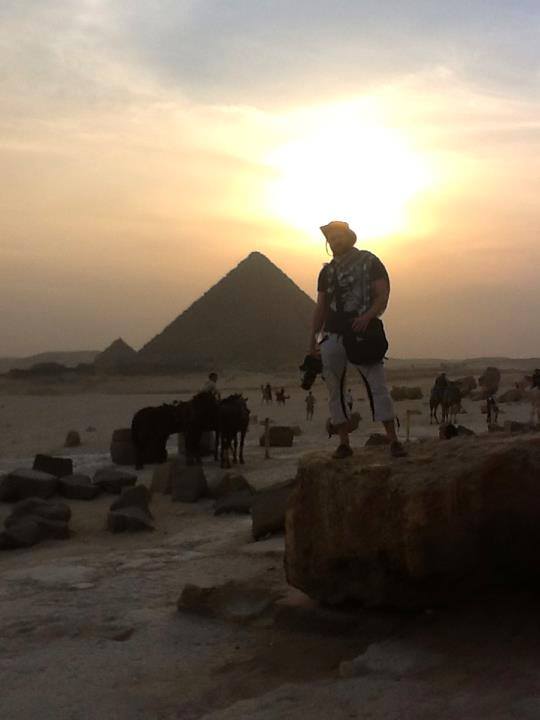
‘In terms of humans, I see the brain much more a receiver than a generator’, VESA says as he hints towards his understanding of the divine.
‘My traumatic experience of nearly drowning was so pivotal to my creative growth because it brought me violently close to that origin point, the point of ultimate connection to God. Maybe I remembered something, maybe I have been here before – it is a possibility’, VESA expands.
Omid illustrates our longing for our origins beautifully through a famous opening to a poem by Rumi, which describes the haunting sound of the reed pipe, longing to return to the whole it was cut from. Perhaps we are like the reed pipe, the divine breath moving through us, but always hankering to get back into unity with our origin.
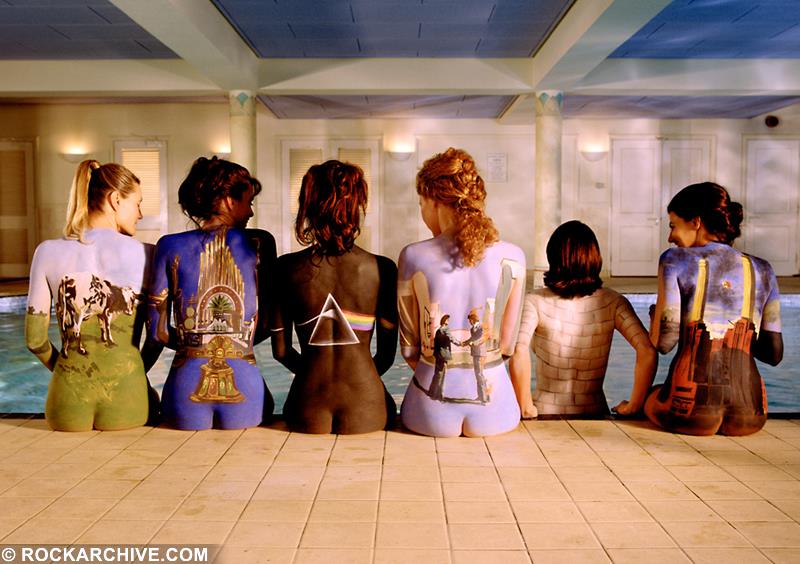
The Pink Floyd “Back catalogue” poster on VESA’s wall as a teenager likely had a significant impact on his life choices later on.
Different bodies
Omid draws a parallel between VESA’s method of bodypainting and seeing inanimate objects as bodies, such as the body of a car that Omid had seen at an event recently. Does VESA see his Art Cars and other painted objects as a continuation of his bodypainting methodology?
‘In some sense, it is still human centric, because these different bodies are still painted for humans to admire’, VESA starts.

The Dr Marwan Tesla covered in art in Dubai also has a digital douible made by Zoan.
‘I also want to be incredibly respectful towards Islam, and not to portray a human as an idol, so I have a lot to study on how to bring to the front my goal of showcasing the divine spark in the human form, how He made us so magnificently’, VESA says.
‘In that spirit of further conversation and discussion, we could go on for so much longer, but I want to invite you to the possibility of having a second episode with you,
‘Inshallah’, VESA says.
Watch the conversation on Youtube
Watch it on Spotify
______
Until next time,
VESA & Lotta
Crypto & NFT Artist
All links to physical, NFTs, and more below
http://linktr.ee/ArtByVesa

Ernest Cline and Dan Farah have co-founded Readyverse to develop a metaverse for Ready Player One and other IPs.
Metaverse platform The Sandbox is aiming to make India its largest market within the coming 24 months.

The Web3 metaverse developer Improbable sold its gaming venture, The Multiplayer Group, as a part of its venture strategy for 2024.
Welcome to the world of Metaverse land and property investment! This guide provides essential insights into buying and owning digital real estate. From understanding metaverse land value to navigating legalities, we cover all you need to start your journey in the virtual property market.
Metaverse land is a revolutionary aspect of digital real estate within virtual worlds. Unlike tangible property, this land exists exclusively in online environments such as Decentraland, a prime example of a thriving metaverse platform. What sets metaverse land apart, and integral to its function and value, is its close relationship with Non-Fungible Tokens (NFTs).
NFTs are critical in defining ownership of metaverse land. When you purchase a plot of land in the metaverse, you’re essentially acquiring an NFT. This NFT is unique, holding specific information about your piece of digital property, such as its coordinates, size, and other distinct characteristics. This uniqueness ensures that every metaverse land parcel is one-of-a-kind, with its ownership securely recorded and verifiable on the blockchain.
The use of NFTs for metaverse land transactions eliminates the risk of duplication or fraud, common concerns in the digital world. This secure framework not only provides peace of mind for buyers and sellers but also enhances the land’s value as a digital asset. Notably, land transactions using NFTs are typically executed with cryptocurrencies, marrying two pivotal aspects of the digital economy.
The phrase “I just bought more land in the metaverse” reflects an emerging trend in digital investment, underscored by the role of NFTs in these transactions. As the metaverse grows, so does the sophistication and appeal of owning NFT-based land, making it a coveted asset in the digital age.
Understanding The Value Of Metaverse Property
Grasping the value of metaverse property requires an appreciation of its unique characteristics. Unlike physical real estate, the worth of metaverse land isn’t based on location in the traditional sense. Instead, it hinges on factors like the popularity of the virtual platform, potential for user engagement, and the digital neighborhood’s growth prospects.
In the metaverse, properties in high-traffic areas, akin to bustling city centers, often hold higher value. These locations, frequented by more users, offer greater visibility and potential for commercial activities. Similarly, proximity to popular virtual landmarks or hubs can significantly boost a property’s value, mirroring the real-world real estate dynamics.
Another key aspect influencing metaverse property value is its potential for customization and development. Unlike physical properties, metaverse land offers limitless possibilities for building and modification without the constraints of physical resources or geography. This freedom allows owners to create unique spaces, from immersive gaming zones to innovative retail outlets, adding to the land’s intrinsic value.
The speculative nature of the metaverse real estate market also plays a crucial role. Much like early investments in emerging neighborhoods, buying property in underdeveloped or new areas of the metaverse can be a gamble with high potential rewards. As the metaverse platform grows and attracts more users, these early investments may see significant appreciation.
Buying land in the metaverse is a process that blends traditional real estate principles with the nuances of digital transactions.
A Step-by-Step Guide: How To Buy Metaverse Land
To start your journey in acquiring virtual property, follow these key steps:
1. Choose A Metaverse Platform: Begin by selecting a metaverse platform like Decentraland or others that offer virtual land. Each platform has unique features and communities.
2. Set Up A Digital Wallet: To buy metaverse land, you’ll need a digital wallet compatible. This wallet will store your digital currency and hold any NFTs representing your land ownership. The most popular option is ConsenSys’ MetaMask.
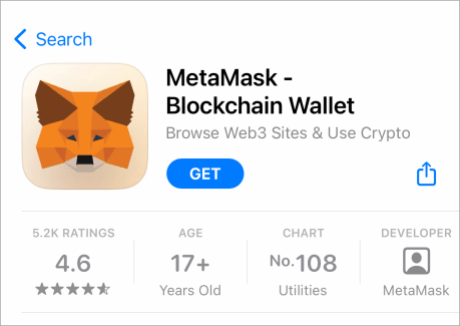
3. Fund Your Wallet: Purchase a cryptocurrency. Ensure your wallet is sufficiently funded for both the purchase price and any associated transaction fees.
4. Explore Available Properties: Platforms typically have marketplaces or listings showing available land parcels. Spend time exploring different areas and consider factors like location within the metaverse, potential for traffic, and development possibilities.
5. Understand The Pricing: Metaverse land prices can vary widely. Research current market trends, check metaverse land price charts.
6. Make A Purchase: This process often involves bidding in an auction or buying at a set price. The transaction will be recorded on the blockchain, ensuring the security and authenticity of your purchase.
7. Develop Your Land: After purchase, you can start developing your virtual land. The scope of development depends on the platform’s rules and your creativity—from constructing buildings to creating virtual experiences.
8. Stay Informed: The metaverse is rapidly evolving. Keep up with trends, platform updates, and community insights.
Metaverse Land For Sale: How To Find The Best Deals
Finding the best deals when looking for metaverse land involves a blend of market savvy, timely research, and strategic planning. Here’s how to secure valuable virtual property without overpaying:
“I Just Bought More Land In The Metaverse”
The phrase “I Just Bought More Land In The Metaverse” resonates both as a popular cultural reference and a statement reflecting a growing investment trend in the digital world.
As a cultural reference, this phrase gained fame from a song, embedding itself in popular culture. The song captures the essence of the metaverse’s allure, highlighting the excitement and novelty of owning digital land. Its lyrics and rhythm tap into the futuristic and innovative spirit of the metaverse, making the concept of virtual land ownership more mainstream and relatable.
“I Just Bought More Land In The Metaverse” is a song from an advertisement for Atlas Earth, a game where users buy virtual real estate. The ad gained attention for its catchy tune and the character resembling Derek Anderson, the game’s marketing associate. This song and its ad became a meme, highlighting the growing interest in virtual real estate.
However, Atlas Earth faced scrutiny, with some questioning its legitimacy and criticizing the long time required to earn real money from in-game investments. The game’s concept of turning virtual land into a monetizable asset sparked both interest and controversy in the realm of digital investments.
Technical Hurdles: Buying Land In The Metaverse
Navigating the technical aspects of buying land in the metaverse can be challenging, especially for those new to the concept. Understanding these hurdles is crucial for a smooth transaction and effective management of your digital real estate.
Understanding metaverse land prices is crucial for making informed investment decisions. Here are key factors to consider:
Remember, metaverse land prices are dynamic and influenced by various factors, making thorough research a key component of your investment strategy.
Best Place To Buy Metaverse Land: Top Platforms
When considering where to buy metaverse land, these top platforms stand out:
Each platform caters to different needs and investment styles, making it important to choose one that aligns with your goals.
How Much is Land In The Metaverse?
Determining the cost of land in the metaverse requires considering various factors, including platform, location, size, and demand. Prices can range significantly, with some notable sales reaching substantial amounts.
For instance, in Decentraland, the Fashion Street Estate sold for approximately $2.42 million, or 618,000 MANA, encompassing 116 land parcels. Another significant sale was in Axie Infinity, where a Genesis Plot sold for around $2.33 million, or 550 WETH, known for its rarity.
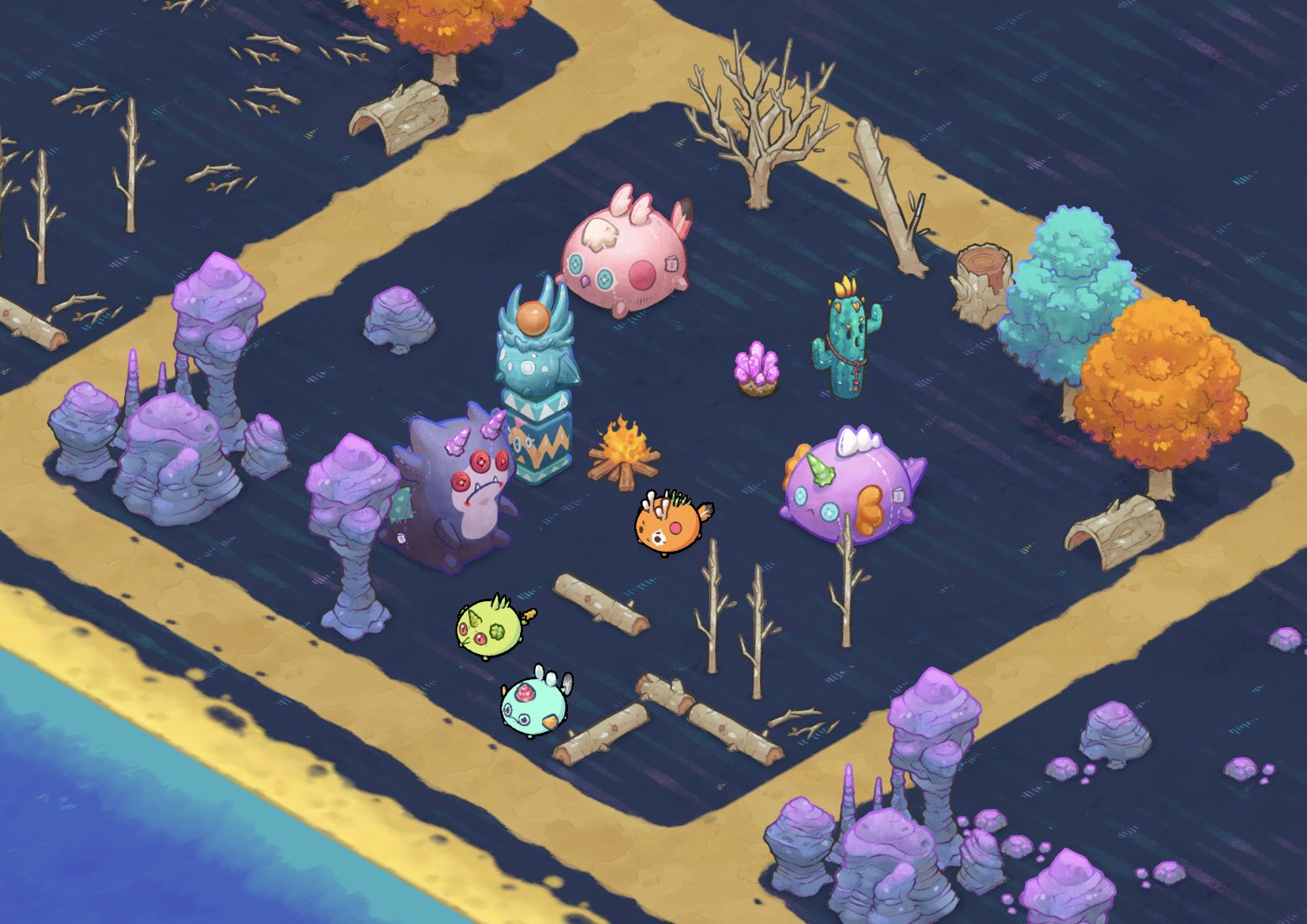
Additionally, in Decentraland, the Hotel Booking Marketplace BookLocal sold a parcel for about $1.09 million, or 210,000 MANA.
Other notable sales include Land Parcel #4247 in Decentraland, which went for around $914,000, or 1,300,000 MANA, located near key virtual locations like Dragon City, and the Coliseum’s premium NFT asset in Decentraland, acquired for $756,000, or 225,000 MANA tokens. Furthermore, a premium estate in Decentraland was purchased for approximately $709,000, or 759,000 MANA.
These examples show the higher end in pricing and the potential for high-value transactions in the metaverse, influenced by the platform’s popularity, the virtual land’s location, and its potential for development.
Where To Find A Metaverse Land Price Chart?
To find a metaverse land price chart, you can visit several online resources:
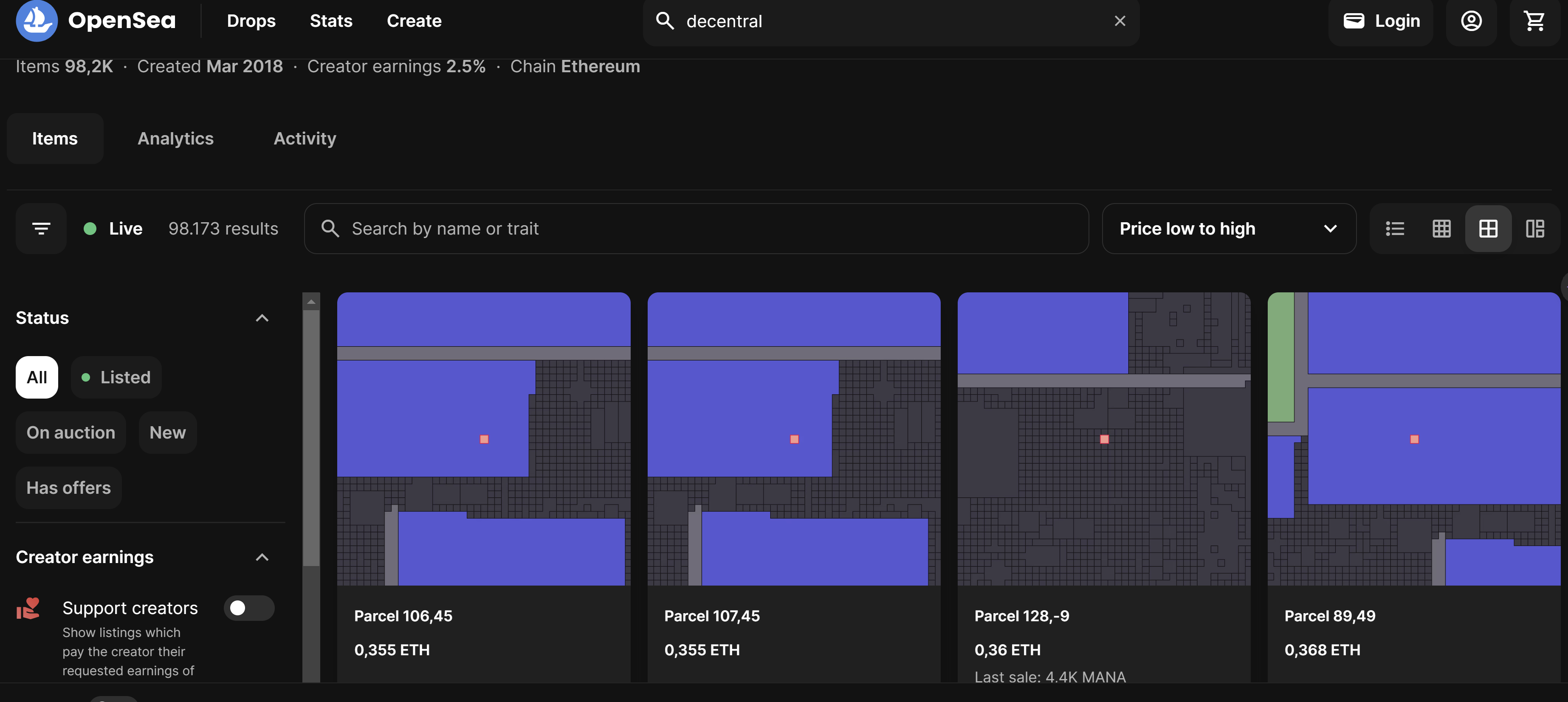
Decentraland is a trailblazer in the metaverse realm, offering a virtual world where users can buy, develop, and engage with digital land. This platform stands out for its use of blockchain technology, enabling users to have true ownership of land as Non-Fungible Tokens (NFTs). This unique feature allows for extensive customization and development of virtual spaces, from building structures to creating interactive experiences.
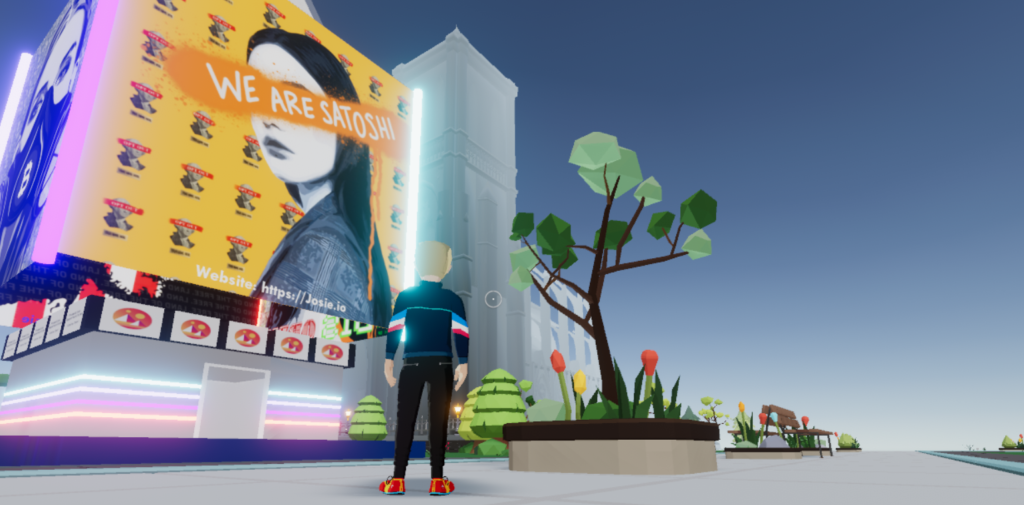
The popularity of Decentraland stems from its dynamic economy, powered by its native cryptocurrency, MANA. Users engage in various transactions, from land purchases to availing services within its ecosystem. The platform is renowned for its vibrant community and diverse events, ranging from art exhibitions to live concerts, fostering a rich social experience.
Decentraland’s accessibility via web browsers makes it a user-friendly gateway into the metaverse, attracting a wide range of users from casual explorers to serious investors and creators. Its blend of technology, economy, and community engagement positions it as a prominent and influential player in the expanding world of virtual real estate.
Navigating the legal and practical aspects of metaverse property requires a comprehensive understanding of several complex factors. Legally, the ownership of digital land, often tied to Non-Fungible Tokens (NFTs), is governed by the platform’s terms of service and the overarching legal framework surrounding digital assets.
This involves understanding property rights, regulatory compliance across different jurisdictions, and the tax implications of virtual real estate transactions and profits.
Practically, managing metaverse property means adhering to the specific rules and guidelines of the chosen platform. Investors must be aware of potential policy changes that can impact land usage, development possibilities, and value.
Additionally, assessing the long-term sustainability of the platform and the engagement level of its community is crucial for ensuring the enduring value of the investment. As the metaverse evolves, so do the legal and practical landscapes, making ongoing education and adaptability key for anyone involved in this emerging sector.
Can You Buy Property In The Metaverse? Legal Perspectives
Buying property in the metaverse, typically through NFTs, is a legally complex process. Legally, these transactions are recognized as legitimate ownership transfers, recorded on a blockchain. However, the enforceability of property rights in the metaverse is still a grey area, as laws governing digital assets are in their infancy and vary widely between jurisdictions.
The legal status of metaverse property also intersects with intellectual property rights, data privacy, and consumer protection laws. Additionally, there are questions about jurisdiction: which country’s laws apply to transactions and disputes in a global virtual space?
As the metaverse evolves, so too will the legal frameworks governing it, necessitating ongoing vigilance and adaptability from investors and legal professionals. Therefore, it’s advisable for potential buyers to stay abreast of legal developments and consult with experts in digital asset law.
Digital Property Metaverse: Rights And Regulations
In the metaverse, digital property rights and regulations are distinct from those in the physical world. These rights often depend on the specific virtual environment where the property exists. Platforms may have varying policies on how property can be used, altered, or transferred.
Regulations are still being formed, focusing on how virtual property rights are protected and enforced. Key issues include digital ownership validation, conflict resolution in virtual disputes, and data privacy. As the metaverse becomes more integrated with real-world economies and legal systems, these regulations are expected to become more comprehensive, potentially including cross-jurisdictional laws and international agreements.
Can You Buy Property In The Metaverse?
Yes, you can purchase property in the metaverse, typically as NFTs.
How to Buy Property In The Metaverse?
Select a platform, set up a digital wallet, fund it with cryptocurrency, explore available properties, and then purchase.
Can I Buy Property In The Metaverse?
Yes, anyone with the necessary resources can buy property in the metaverse.
Where To Buy Metaverse Land?
Land can be bought on platforms like Decentraland, The Sandbox, Axie Infinity, or through marketplaces like OpenSea.
How Much Is Land In The Metaverse?
Prices vary greatly, influenced by platform, location, and market demand.
How Much Is Metaverse Land?
The cost can range from modest amounts to millions, depending on various factors.
How Much Does Metaverse Property Cost?
The cost varies widely, depending on the platform, location, size, and other factors.
How Much Does Property Cost In The Metaverse?
Prices can range significantly, with some notable sales reaching into the millions.
How Do You Buy Property In The Metaverse?
Property is purchased through specific platforms or marketplaces using cryptocurrency, with each platform having its own process.
The Metaverse stands at the forefront of digital innovation. A term that’s sparked curiosity and debate, the Metaverse is at the crossroads of technology, social interaction, and cutting-edge cryptocurrency projects. But what is the Metaverse exactly? This question echoes in the minds of tech enthusiasts, investors, and everyday netizens alike.
In this article, we dive deep into the Metaverse’s multifaceted world, exploring its meaning, the key players shaping its future, and the integral role of cryptocurrency in this virtual landscape. From Mark Zuckerberg’s Meta Metaverse, the Apple Metaverse to the revolutionary potential of Metaverse AI, we unravel the complexities and address common queries like “What does the Metaverse look like?” and “Do you need a Metaverse headset or goggles?”
The Metaverse – a term that conjures images of boundless virtual universes and futuristic landscapes. But what does it really mean? At its heart, the Metaverse is an expansive, interconnected digital realm. It’s a collective virtual space, created by the convergence of virtually enhanced physical reality, augmented reality (AR), and the internet.
Envisioned as a place where digital and physical realities coalesce, the Metaverse offers an immersive experience where users can live, work, play, and socialize. It transcends beyond just a gaming or social platform; it’s a new digital frontier where the physical and digital worlds meld seamlessly, powered by technologies like virtual reality (VR), AR, and blockchain.
The concept of the Metaverse, while now gaining mainstream traction, is not new. It finds its roots in science fiction and has been gradually taking shape with the advancement of technology. As we stand on the brink of this new era, the Metaverse is set to redefine our digital interactions, offering a glimpse into a future where our virtual and physical lives become indistinguishable.
But What Is The Metaverse Exactly?
The term “Metaverse” often sparks curiosity and wonder, but defining it can be as complex as the concept itself. The Metaverse is not just a single digital space but a collection of interconnected virtual worlds and environments where users can interact with each other and digital objects in real-time. It’s an immersive, live universe that exists beyond the physical realm we inhabit.
At its simplest, the Metaverse can be seen as the next evolution of the internet. Today’s internet allows us to consume content passively or interact in limited ways. In contrast, the Metaverse provides a fully immersive, 3D experience. It’s a space where the lines between digital and physical realities blur, enabling experiences that extend beyond browsing or social media scrolling.
What sets the Metaverse apart is its emphasis on user agency and interactivity. Here, users are not just viewers but active participants. They can create content, build environments, own virtual real estate, and even have a digital economy powered by metaverse crypto. This economy uses blockchain technology, ensuring secure, decentralized transactions, adding a layer of authenticity to the virtual experiences.
Additionally, the Metaverse is persistent – it continues to exist and evolve even when you’re not logged in. This persistence mimics real life, where the world goes on irrespective of an individual’s involvement, making the Metaverse experience more realistic and engaging.
The Evolution Of The Metaverse Concept
The Metaverse, as we know it today, is the culmination of decades of technological advancements and cultural shifts. Its evolution is a fascinating journey through the realms of science fiction, gaming, and cutting-edge technology.
From Fiction To Reality: The Sci-Fi Roots
The term “Metaverse” first appeared in Neal Stephenson’s 1992 science fiction novel “Snow Crash,” where it described a virtual reality-based successor to the internet. This depiction of a fully immersive digital world captured the imagination of tech enthusiasts and set the stage for future developments.
Gaming: The Early Incarnations
The gaming industry played a pivotal role in bringing concepts of the Metaverse to life. Early video games introduced the idea of digital worlds, and as technology progressed, these worlds became more complex and immersive. Online multiplayer games and virtual worlds like Second Life laid the groundwork for what the Metaverse could become, offering social interaction and digital economies in a virtual space.
Technological Breakthroughs: Building The Foundations
Advancements in VR and AR technologies have been instrumental in shaping the Metaverse. The development of sophisticated VR headsets, Metaverse goggles and AR applications has allowed for more immersive experiences, making the idea of a fully-realized Metaverse more plausible.
Blockchain And Cryptocurrencies: Fueling The Metaverse Economy
The integration of blockchain technology and cryptocurrencies has been a game-changer for the Metaverse. These technologies enable secure, transparent transactions and the creation of digital assets like NFTs (Non-Fungible Tokens), which can be traded and owned within the Metaverse. This economic layer adds a level of realism and functionality to the Metaverse, making it more than just a space for leisure and entertainment.
The Current State: A Work In Progress
Today’s Metaverse is a work in progress, a blend of the visionary concepts from science fiction and the tangible technologies of the present. Companies like Apple, Google and Meta (formerly Facebook) with Mark Zuckerberg at the helm. They are investing heavily in this space, envisioning a future where the Metaverse becomes an integral part of daily life.
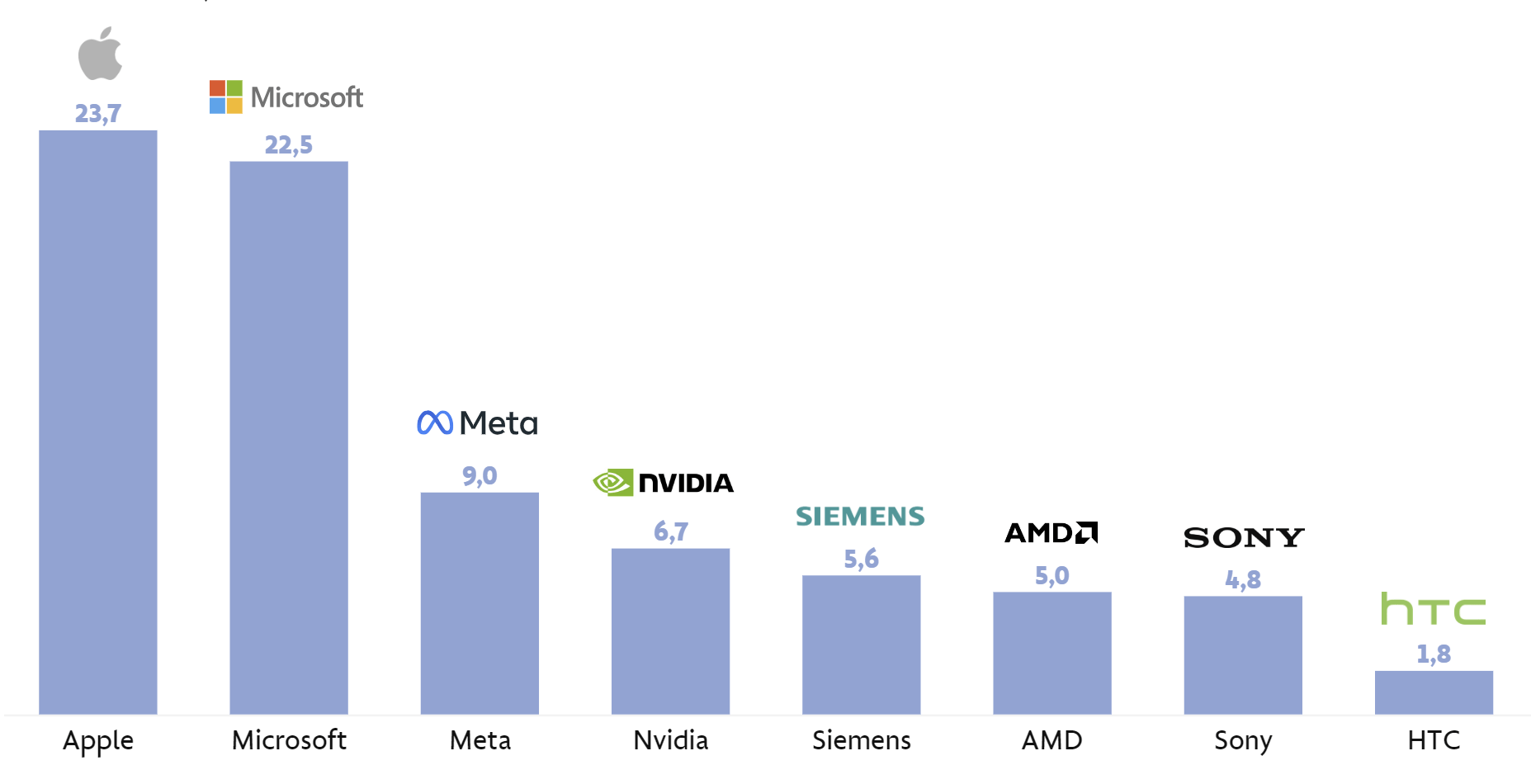
What Does The Metaverse Look Like?
The Metaverse, an ever-evolving digital universe, presents a vast array of virtual worlds, each distinct in its aesthetic and design. Imagine stepping into realms that range from hyper-realistic replicas of real-world cities to fantastical landscapes that defy the norms of physics. The appearance of the Metaverse is shaped by the limitless creativity of its creators and the advancing technologies that bring these visions to life.
Technological advancements play a pivotal role in defining the Metaverse’s look. Cutting-edge graphics and rendering technologies enable environments of stunning detail and realism. Virtual reality adds depth and presence, while augmented reality merges the digital with the physical world, creating a unique hybrid space.
A key feature of the Metaverse is its user-generated content. Users have the freedom to design their own spaces and avatars, leading to a dynamic and constantly changing visual experience. This personalization underscores the Metaverse’s nature as a platform for creativity and expression.
The use of Metaverse headsets and goggles intensifies this experience, offering deeper immersion into these virtual environments. From simple 3D displays to complex systems providing full sensory immersion, these devices vary in complexity and capability.
Do You Need A Metaverse Headset Or Goggles?
In the diverse landscape of the Metaverse, the necessity of VR headsets or goggles varies based on the platform and the experience it offers. While some Metaverse environments are designed for accessibility without specialized equipment, others are built to leverage the immersive capabilities of VR technology.
Metaverses Requiring VR Headsets
Horizon Worlds: Created by Meta (formerly Facebook), Horizon Worlds is a prime example of a Metaverse experience that demands the use of a VR headset, specifically the Oculus Quest 2, for full immersion.
Metaverses Accessible Without VR Headsets
Many Metaverse experiences, however, do not require VR headsets and can be accessed using standard computers, smartphones, or gaming consoles. These platforms offer a more limited field of view compared to VR, but still enable participation in the Metaverse. Examples include platforms like Decentraland and The Sandbox, which do not currently support VR metaverse headsets but are fully accessible through internet-enabled devices.
1. Meta Horizon Worlds
Meta, a global leader in metaverse investments, has developed Horizon Worlds to create a decentralized and immersive online experience. This platform focuses on user-generated content and enables users to interact, own, buy, and sell virtual assets and real estate, all within a blockchain-based virtual world.
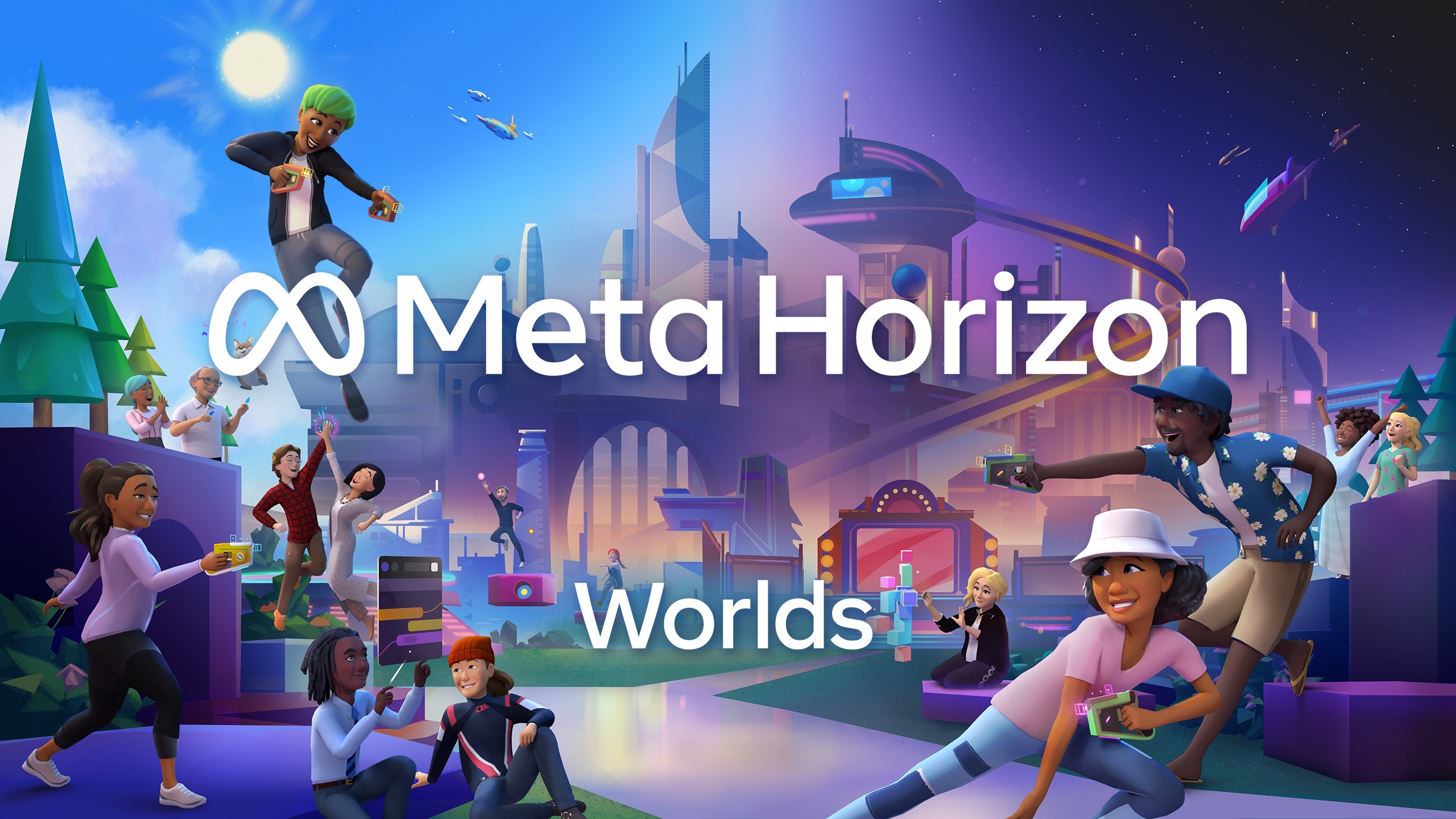
2. Microsoft Mesh
Microsoft Mesh offers a mixed reality platform that enables users to collaborate across devices and locations. It supports creating and experiencing shared virtual and augmented reality environments, making it ideal for collaborative projects and reducing development time and costs.
3. Epic Games
Epic Games, known for popular titles like Fortnite, is developing a metaverse platform that connects players across different games and virtual worlds. It focuses on socializing and gaming in a shared virtual space, leveraging its game development expertise and player base.
4. Google Starline
Currently in the research and development stage, Google Starline aims to enable real-time, 3D communication between people in different locations, using a combination of computer vision, machine learning, and spatial audio.
5. Roblox
Roblox is a global online gaming platform that pioneers metaverse gaming experiences. It enables users to create and share games and experiences, programming games themselves, and playing games developed by others.
6. Decentraland
Decentraland is a blockchain-based virtual reality platform where users can create, monetize content, and trade virtual real estate and assets as NFTs. It provides a decentralized and immersive online world with secure and transparent transactions.

7. The Sandbox
The Sandbox allows users to create and monetize their own virtual worlds and experiences using NFTs on the Ethereum blockchain. It provides tools for users to customize their virtual worlds, experiences, and games.
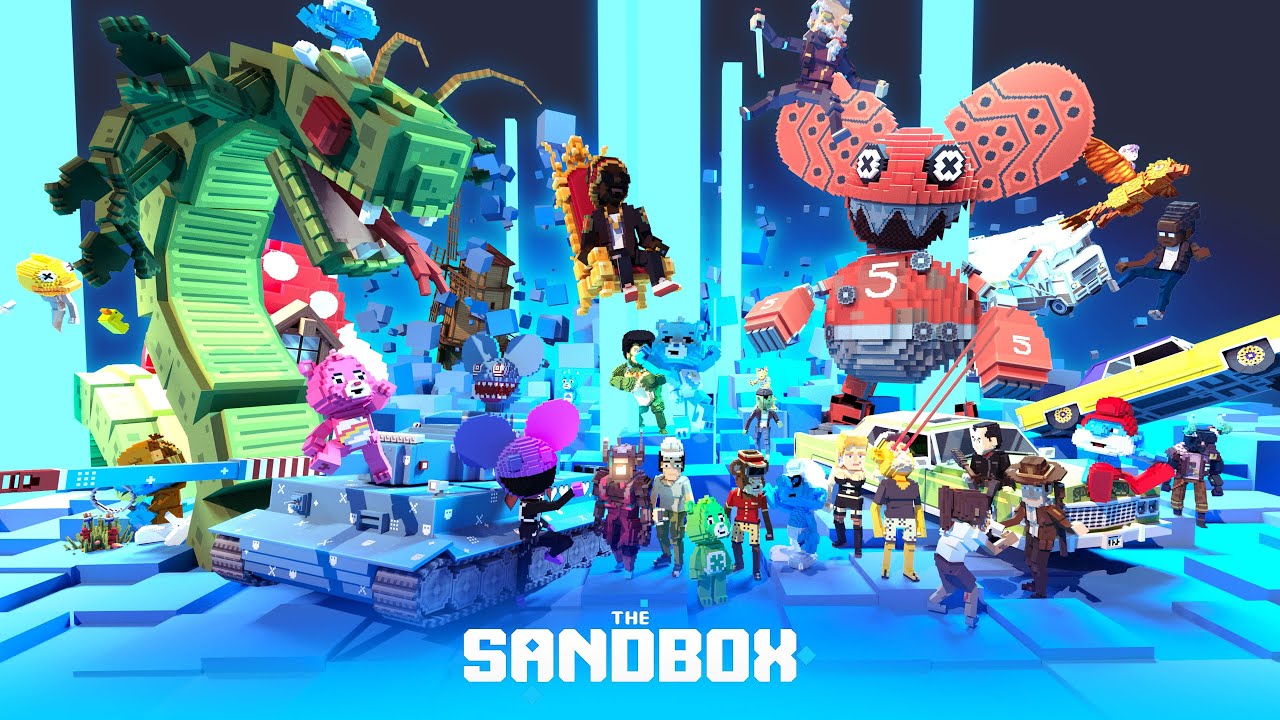
8. Cryptovoxels
Cryptovoxels offers a virtual world platform where users can buy, sell, and own virtual land using cryptocurrency. Built on the Ethereum blockchain, it allows users to build and create their own virtual experiences like games, art installations, and social spaces.
At Meta Connect 2023, Mark Zuckerberg unveiled his ambitious vision for the Metaverse, marking a strategic shift towards the integration of artificial intelligence (AI) with augmented and virtual reality technologies. He envisions the Metaverse as a digital universe where users can interact, socialize, work, and play in immersive environments, reshaping the future of computing and human interaction.
Zuckerberg’s plan includes the introduction of AI-powered virtual assistants with distinctive personalities, embedded within Meta’s apps. These assistants add a new dimension of interactivity and convenience, underscoring Meta’s commitment to advancing AI technologies within the Metaverse.
Moreover, Meta announced the expansion of its social VR platform, Horizon Worlds, to mobile and web versions, aiming to make the Metaverse more accessible to a broader audience. This expansion indicates a focus on inclusivity and the democratization of virtual experiences.
Mark Zuckerberg Metaverse: What’s The Buzz?
The buzz around Zuckerberg’s vision for the Meta Metaverse is centered on several key developments. The release of the Quest virtual reality headset is eagerly anticipated, expected to enhance immersive experiences and open new possibilities for innovative applications in the Metaverse.
Additionally, the introduction of more realistic virtual reality avatars, now with legs, represents Meta’s efforts to create a more immersive and authentic Metaverse experience. This development has piqued interest for its potential to make virtual interactions more lifelike.
Remarkably, Zuckerberg’s vision for the Metaverse is emerging as more ambitious than ever. The focus on AI, advanced VR hardware, and the expansion of Horizon Worlds indicates a commitment to leading the Metaverse era. These strategic decisions and innovations are expected to have significant implications for the future of computing, communication, and entertainment.
Apple’s foray into the mixed reality domain with the Apple Vision Pro is a notable development in the tech industry. Presented at the WWDC, the Vision Pro, priced at $3,499, is Apple’s answer to the evolving concept of the metaverse, but with a unique twist. Instead of conforming to the typical metaverse narrative, Apple brands its device as a “spatial computer,” signaling a distinct approach to augmented and virtual reality.
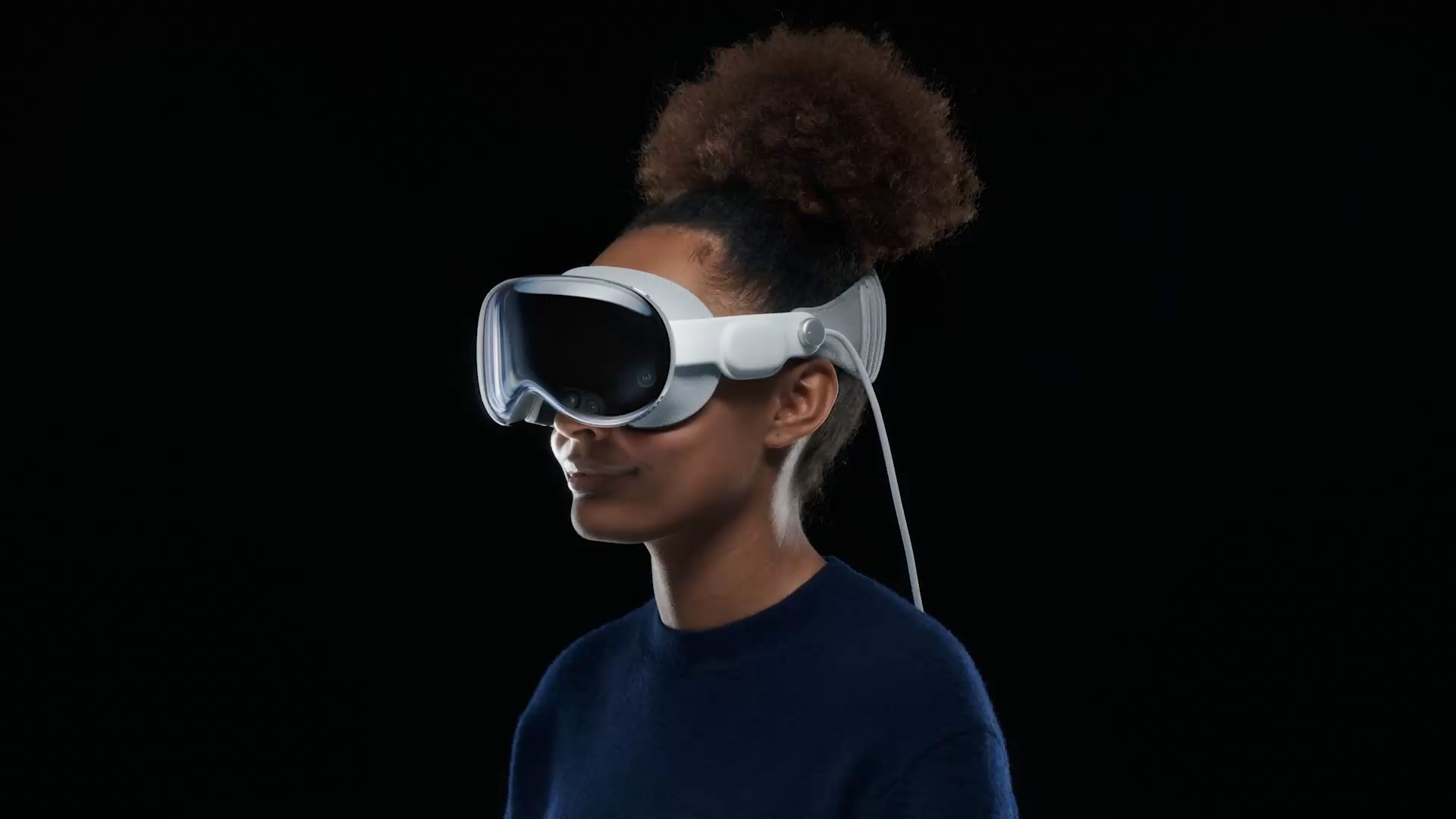
The Vision Pro is not just about creating an alternate virtual world; it’s about enriching real-world experiences through advanced AR and VR capabilities. It integrates high-resolution micro-OLED displays and sophisticated sensing technologies, including room and content mapping, head and hand tracking, and enhanced low-light performance. This technology, paired with a controller-free interface, positions the Vision Pro as a tool for enhancing productivity and leisure activities in a more intuitive, immersive way.
Apple’s design philosophy also shines through in the Vision Pro. With its sleek design, incorporating three-dimensional laminated glass and an aluminum frame, the device echoes Apple’s reputation for premium aesthetics. This focus on design is coupled with the aim of delivering a seamless user experience, blending physical and digital realms in a way that feels natural and intuitive.
In summary, the Apple Vision Pro represents a significant shift from traditional metaverse concepts. It sets Apple apart in the mixed-reality landscape, highlighting its commitment to innovation and user-centric design.
The metaverse technology landscape in 2023 offers a variety of goggles, each with unique features catering to different needs and preferences. Here are some of the top choices:
1. Project Cambria (Oculus Quest Pro)
Released in October 2022, this advanced Oculus Metaverse headset is known for its realistic color pass-through and facial recognition. It’s suitable for both AR and VR applications, priced at $1,500.
2. Apple Vision Pro
Priced at $3,499, the Vision Pro’s are Apple’s first spatial computer, combining augmented reality (AR) and virtual reality (VR) capabilities.
3. MetaQuest 2
A more affordable option at $399, MetaQuest 2 offers hand tracking, 128 GB of storage, and PC compatibility. It’s known for wireless functionality, excellent touch controllers, and a comfortable design.
4. Lenovo Think Reality A3
These smart glasses, priced at $1,499, are less bulky than traditional headsets and preferred by professionals. They offer access to personalized virtual workspaces and can connect to Windows laptops.
5. HP Reverb G2
Renowned for its image resolution (2,160×2,160 pixels per eye), the HP Reverb G2 provides crisp audio and a comfortable fit at $499. It requires wired connectivity and is known for its high-resolution display.
6. HoloLens 2
One of the most expensive options at $3,500, HoloLens 2 offers “Mixed Reality” experiences. It targets industrial solutions and is used in various industries for training and efficiency improvement.
7. Sony PlayStation VR
Designed primarily for gaming and priced at $299, Sony PSVR offers a 1920x1080p resolution and powerful 3D audio. It provides access to a wide array of VR games and is popular among gaming enthusiasts.
Metaverse Stocks And Stock Prices
Investing in metaverse stocks has become a key focus for investors looking to capitalize on the growth of virtual worlds and related technologies. Metaverse stocks encompass a range of companies, from those creating hardware like VR headsets to firms developing software platforms and digital environments.
Companies such as Meta (formerly Facebook), Apple, Microsoft, Siemens, AMD, Sony and NVIDIA are at the forefront, with their significant investments in metaverse technologies influencing their stock prices. Additionally, gaming companies like Roblox and Epic Games, known for their interactive and immersive platforms, are also pivotal in this space.
The stock prices of these companies often reflect their progress and potential in developing metaverse technologies. For instance, announcements of new products or partnerships in the metaverse realm can lead to fluctuations in stock prices. However, it’s important to note that investing in metaverse stocks carries risks, as the sector is still evolving and can be influenced by technological advancements and market trends.
As the metaverse continues to grow, with more companies entering the space and existing ones expanding their offerings, the stock market’s interest in these companies is likely to increase. Investors are keenly watching this sector for opportunities to invest in what many see as the next big technological frontier.
Cryptocurrency plays a pivotal role in the Metaverse, acting as the backbone of its economy. In these virtual worlds, crypto facilitates transactions, including the purchase of virtual goods, real estate, and services. It provides a decentralized and secure way to handle these transactions, ensuring transparency and trust among users.
Metaverse NFTs, Tokens, And Crypto Coins
In the Metaverse, Non-Fungible Tokens (NFTs) are crucial for establishing ownership of digital assets. Unlike traditional cryptocurrencies, NFTs are unique and cannot be exchanged like-for-like. This uniqueness makes them ideal for representing ownership of digital properties in the Metaverse. Virtual land or buildings are often tokenized as NFTs. These NFTs can be bought, sold, or traded, much like physical real estate.
Metaverse tokens and coins, meanwhile, act as the currency for various transactions within these virtual worlds. Each Metaverse platform often has its own specific token, enabling users to engage in the ecosystem by purchasing virtual goods, services, or even access to certain areas or experiences. These tokens and coins can fluctuate in value, similar to real-world currencies, reflecting the dynamic nature of the Metaverse’s economy.
Virtual Real Estate In The Metaverse
Virtual real estate in the Metaverse refers to the digital land or properties available within these virtual worlds. Just like real-world real estate, these digital spaces can be bought, sold, and developed.
The ownership of these virtual properties is often managed through NFTs, providing a secure and verifiable record of ownership. Virtual real estate has become a lucrative market, with individuals and businesses investing in these digital assets for various purposes, including creating virtual stores, hosting events, or simply for investment and trading.
Top Metaverse Crypto Projects
Several Metaverse crypto projects have gained prominence, each offering unique functionalities within their respective virtual worlds:
These projects are at the forefront of integrating blockchain technology with virtual worlds, creating vibrant ecosystems for users to explore, interact, and transact.
Decentraland Metaverse: A Pioneer
Decentraland represents a pioneering effort in the Metaverse landscape. It is a decentralized virtual world where users can buy, sell, and develop virtual real estate. Built on the Ethereum blockchain, it leverages NFTs for property ownership and MANA, its native cryptocurrency, for transactions. Decentraland stands out for its user governance model, where owners of virtual land have a say in the platform’s policy and development decisions, making it a unique experiment in digital democracy and economy.
The Sandbox Metaverse: An Interactive Experience
The Sandbox is a user-generated content platform in the Metaverse, allowing individuals to create, control, and monetize their virtual experiences. Built on the Ethereum blockchain, it utilizes SAND tokens and NFTs for transactions and asset ownership. The platform encourages creativity, offering tools for users to design their own games, digital assets, and interactive experiences. The Sandbox has forged partnerships with various brands and entities, expanding its ecosystem and user engagement.
Otherside Metaverse
Otherside is developed by Yuga Labs and associated with the Bored Ape Yacht Club (BAYC) NFTs. Built on the Ethereum network, it’s a world-building platform where players explore and interact using avatars. Described as a 2D strategy game for collectors, it promises a narrative intertwined with the entire metaverse.
Yuga Labs has been dedicated to building Otherside as part of its Web3 initiatives. The metaverse aims to create a persistent and immersive virtual world for participants, aligning with the broader concept of metaverses. Notably, Otherside is intricately linked to the Bored Ape Yacht Club ecosystem, offering a unique and interconnected experience for users.
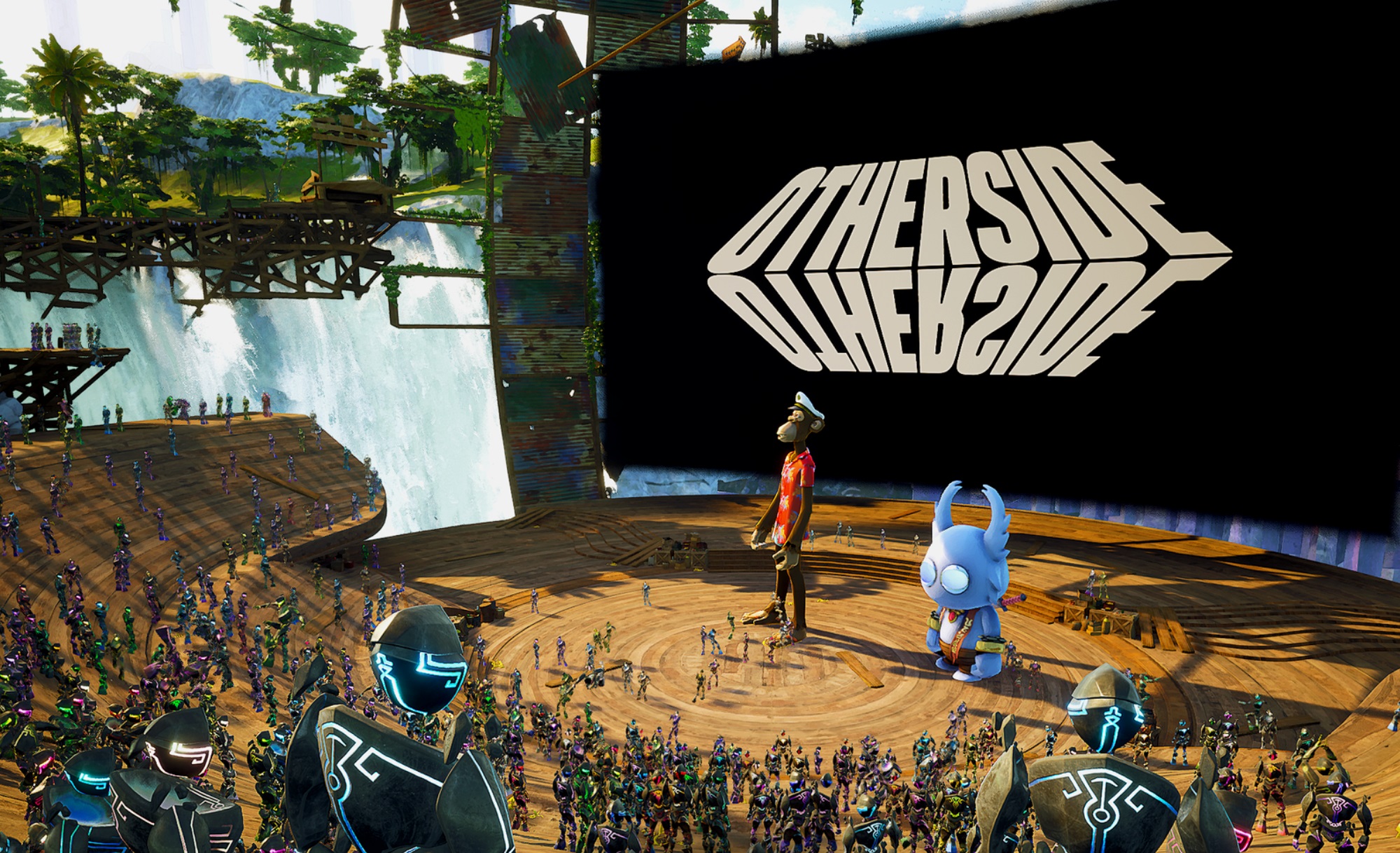
The question of whether the Metaverse is failing requires a multi-faceted analysis. You need to consider various aspects such as user adoption, development, market trends, and socio-economic impacts.
User Adoption:
The global Metaverse user base is expected to surpass 1.4 billion by 2030, with user penetration forecasted to hit 18%. Notably, the Metaverse had over 400 million daily users in 2022, with major contributions from platforms like Roblox, Minecraft, and Fortnite.
User Interest:
Survey participants, with 90% expecting interactive experiences to evolve beyond video games, anticipate the Metaverse to significantly impact entertainment. Fashion and retail sectors are also exploring Metaverse opportunities. Consumer interest in the Metaverse for social connections is evident. Many express excitement about using it for family and friend interactions, exploring digital worlds, and remote work.
Investment Trends:
Investment in Metaverse-related technology surged in 2022, drawing in $120 billion from January to May 2022, more than doubling the investment of 2021.Facebook (now Meta) has been a significant player, planning to spend over $100 billion on Metaverse development over a decade. However, in 2023, Meta has reduced its emphasis on the Metaverse, shifting focus to generative AI.
Challenges And Public Perception:
More than 77% of people express concerns about the Metaverse’s potential harmful impacts on society. These concerns include addiction and mental health issues. Notably, public interest in the Metaverse has declined, with Google searches for the term dropping to only 5% of its peak as of 2023.
Future Projections:
Despite the challenges, forecasts suggest the Metaverse market could reach $936.57 billion by 2030. Proponents believe the current issues are just growing pains and that the Metaverse’s development is inevitable.
Metaverse Canceled?
Based on the current data and trends, it’s premature to declare the Metaverse “canceled.” While there are significant challenges, such as declining public interest, investment pullbacks, and concerns over societal impacts, there is still considerable engagement and investment in the Metaverse. Major tech companies, although shifting priorities, continue to explore its potential, and user adoption in certain sectors remains high. The Metaverse is evolving, and its future success will largely depend on how it adapts to these challenges.
Metaverse AI And Its Revolutionary Impact
Artificial Intelligence (AI) in the Metaverse is revolutionizing how we interact with digital environments. AI in the Metaverse enhances user experiences through intelligent virtual assistants, adaptive environments, and personalized content. These AI-driven systems can learn from user interactions, adapting to preferences and behaviors to create more engaging and meaningful experiences.
AI also plays a key role in developing more lifelike avatars and non-player characters (NPCs). It makes virtual interactions feel more natural and realistic. Additionally, AI is instrumental in analyzing vast amounts of data generated within the Metaverse. It helps to optimize and secure these virtual worlds.
The integration of AI in the Metaverse opens up possibilities for more advanced gaming, social interactions, and virtual economies. It sets the stage for an increasingly immersive and interactive future in virtual spaces.
What’s The Metaverse?
The convergence of virtually enhanced physical reality and physically persistent virtual space creates the Metaverse. It is collective virtual shared space that includes the sum of all virtual worlds, augmented reality, and the internet.
How Does The Metaverse Work?
The Metaverse operates as an immersive, interactive virtual environment. Users, represented by avatars, can explore, socialize and play games. They engage in various activities, often powered by VR and AR technologies.
What Is The Metaverse Meaning?
The term “Metaverse” signifies a comprehensive virtual realm. It merges multiple aspects of technology, including virtual reality and augmented reality.
How Much Does The Metaverse Cost?
The cost of the Metaverse varies based on the platform and usage. It ranges from free access to certain worlds, to significant investments for advanced VR equipment and digital assets like NFTs.
What Can You Do In The Metaverse?
In the Metaverse, users can engage in a wide range of activities. This includes gaming, attending virtual events, socializing, creating and trading digital assets, and exploring virtual environments.
What Happened To The Metaverse?
The Metaverse is continuously evolving. Recent developments include technological advancements, increasing corporate investments, expanding user bases, and ongoing debates about privacy and regulation.
What Is Metaverse Crypto?
Metaverse crypto refers to cryptocurrencies used within Metaverse platforms. These digital currencies enable transactions, purchases, and investments within the virtual space.
What Does The Term Metaverse Refer To?
The term “Metaverse” refers to a virtual space, created by the fusion of virtual reality, augmented reality, and the internet. It serves as a platform for social interaction, entertainment, and commerce.
Meta Cancels The Metaverse, True?
Meta has spend over $100 billion on Metaverse development over a decade. But, in 2023, Meta has reduced its emphasis on the Metaverse, shifting focus to generative AI.
What Is Metaverse Technology?
Metaverse technology encompasses virtual reality (VR), augmented reality (AR), blockchain, artificial intelligence (AI), and 3D reconstruction.
What’s A Metaverse?
A Metaverse is an interactive environment where users can interact, play games, socialize, and engage in a variety of activities. It often incorporates elements of VR and AR.
What Can You Do in The Metaverse?
Activities in the Metaverse include gaming, attending virtual concerts and events, socializing, building and exploring virtual worlds. It also includes trading digital goods like NFTs.
What Does The Metaverse Look Like?
The Metaverse can have varied appearances, from realistic to fantastical landscapes, depending on the platform. It is a digital universe with diverse environments, avatars, and experiences.
What Is The Snow Crash Metaverse?
Neal Stephenson’s novel “Snow Crash” introduced the Snow Crash Metaverse concept. He depicts it as a virtual reality-based successor to the internet and inspiring modern Metaverse concepts.
How Much Did The Metaverse Cost?
The cost of developing the Metaverse is ongoing and hard to quantify. It involves massive investments in technology, infrastructure, and content creation across various industries and companies.

The American thrash-metal band Megadeth released a new NFT collection aiming to connect with its community in both physical and digital reality.